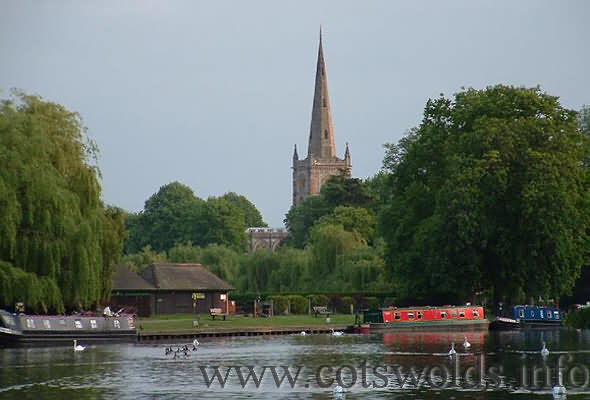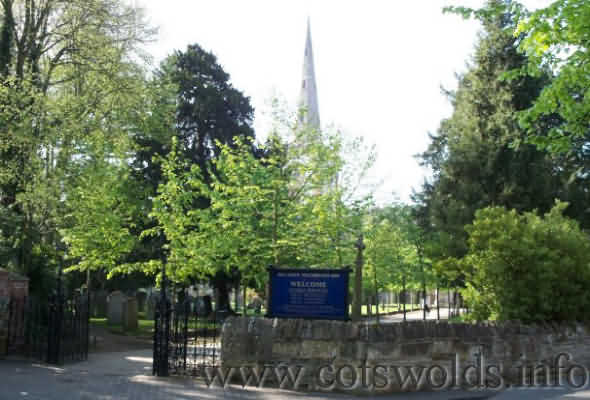 |
| The Local Time is Saturday, 27-Jul-2024 07:30:33 CEST |
Holy Trinity Church |
|
|||
| YOU ARE HERE: Home Page > Places to Visit > Stratford-upon-Avon > Trinity Church |
|
|
 |
|
 Holy Trinity Church - viewed from Across the River Avon  Holy Trinity Church - Entrance from Old Town  Holy Trinity Church - View towards the alter with Shakespeare's grave toward left side front  Holy Trinity Church - Close up of Shakespeare's grave in the floor and statue on left wall Location Map of Holy Trinity Church- Click on blue marker for details and to obtain driving directions |
||||||||||||||||||||||||||||||||||||||||||||||||||||||||
|
||||||||||||||||||||||||||||||||||||||||||||||||||||||||
The Shakespeare ChurchCollegiate Church of the Holy TrinityParish office, Old Town, Stratford upon Avon, Popularly known as the Shakespeare church, there has been a church on or near this site since 845 AD. It was first mentioned then in a charter and was constructed of wood. In 1210 the origins of the present church began. Built in crucifix form it contains a Chancel, Nave, North Transept and South Transept. The north transept being out of bounds to visitors, with this exception visitors are welcome to see this most interesting church . The chancel has 26 carved Misericord seats, these depict Angels, Mythical beasts and men and women fighting. Within the chancel is the tomb of William Shakespeare who lies buried next to his wife. The nave holds much interest with its glass and memorials.
Situated centrally is the Tower which houses a ring of 10 bells, whose origins are sometime before 1502 when a legacy of 6 shillings and eight pence was left towards their restoration. The present bells were cast in 1948 by Taylor’s of Loughborough. In the porch a is a small door of 15th century with a knocker that was used by persons seeking sanctuary. The church has an attractive approach, the pathway is lined by trees that represent the tribes of Israel and the 12 Apostles.
Origination of the word 'Bonfire'In Shakespeare's day it was customary to move bones from the graveyard, and the tombs within the church, into a charnel house to make way for more burials. From time to time, the bones in the charnel house were burned. This was commonly known as the 'bonefire of the vanities'. Thus the origin of the name applied to the fires around the UK (called Bonfires) on 5th November every year to celebrate the failed gunpowder plot in 1605 by Guy Fawkes and his associates in the blowing up of the Houses of Parliament and killing of King James I of England. To avoid his bones following the same fate Shakespeare had the following curse inscribed on his grave: GOOD FRIEND FOR JESUS SAKE FORBEARE, Sanctuary for FugitivesThe north door of the Holy Trinity Church has a sanctuary knocker. Any fugitive that reached the knocker could claim temporary shelter in the church safe from their pursuers for a period of 37 days. The right of sanctuary can be traced back to Saxon times and the Normans continued to observe the practice. The custom of the right of sanctuary was recognised throughout the land up to the highest level and lasted until1623. Failure to observe it incurred penalties of excommunication or death. This was an attempt by the church to alleviate the severity of the laws of the time and offer a criminal the chance to atone. The only people who could not claim the right of sanctuary were witches, heretics or those who had committed a crime in church. During the period of sanctuary the fugitive was expected to be obedient and contrite, confessing his sins and discuss his case with the bishop or priest. At the end of the period the fugitive would have to decide whether to leave and stand trial or to plead guilty and 'abjure the realm' - a medieval form of deportation or banishment. An abjurer would usually have to leave the realm form a port of some distance away, and would have to make the journey dressed in sackcloth and ashes, bare foot and carrying a cross. If he strayed from the main road he would be executed on the spot. Visitor InformationFor those wishing to visit Shakespeare’s tomb a donation towards the church upkeep is requested - £1.50 for adults and 50 pence for students. Opening hours are - Spring and Autumn - (March and October) |
||||||||||||||||||||||||||||||||||||||||||||||||||||||||
|
||||||||||||||||||||||||||||||||||||||||||||||||||||||||
| BACK TO TOP | ||||||||||||||||||||||||||||||||||||||||||||||||||||||||
Holy Trinity Church at Statford upon Avon |
||||||||||||||||||||||||||||||||||||||||||||||||||||||||
| This page last modified Friday, 12-Mar-2021 15:07:12 CET | ||||||||||||||||||||||||||||||||||||||||||||||||||||||||









 Shakespeare is buried just below the altar in the Chancel of Holy Trinity Church, Stratford-upon-Avon. A bust of Shakespeare, in the wall beside the grave was set up about seven years after his death and within the lifetime of his wife, Anne Hathaway. Its tanned and vaguely piratical appearance is said to be a good likeness of the Bard.
Shakespeare is buried just below the altar in the Chancel of Holy Trinity Church, Stratford-upon-Avon. A bust of Shakespeare, in the wall beside the grave was set up about seven years after his death and within the lifetime of his wife, Anne Hathaway. Its tanned and vaguely piratical appearance is said to be a good likeness of the Bard. 